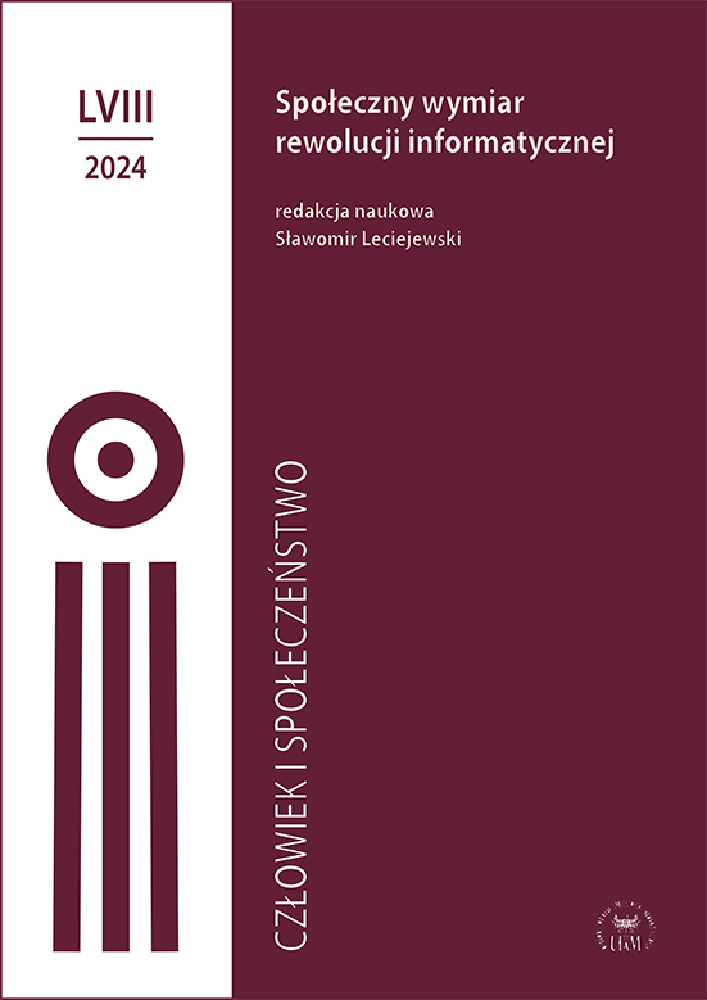Abstract
The rapid development of AI technology in recent years has resulted, among other consequences, in renewal and dominance of connectionistic way of description of cognitive activities of both humans and computational machines. This approach results in new possibilities to compare the performance of digital AI-type computational artefacts with information processing systems of biological and evolutionary origin. The aim of this paper is to show how consequences of this approach towards the problem of computational intelligence look like. The second goal of presented research is to test the thesis of the possible superiority of systems described as immortal computing type over systems presented as mortal computing type.
References
Bolter, D. (1990). Człowiek Turinga. Warszawa: PIW.
Brooks, R.A. (1991). Intelligence without Representation. Artificial Intelligence, 47, 139–159. DOI: https://doi.org/10.1016/0004-3702(91)90053-M
Christian, B. (2020). The Alignment Problem: Machine Learning and Human Values. New York: W. W. Norton & Company.
Gunkel, D. (2022). Person, Thing, Robot: A Moral and Legal Ontology for the 21st Century and Beyond. Boston: MIT Press. DOI: https://doi.org/10.7551/mitpress/14983.001.0001
Hinton, G. (2023). The Forward-Forward Algorithm: Some Preliminary Investigations. https://arxiv.org/abs/2212.13345
Jackson, R., Williams, T. (2020). On Perceived Social and Moral Agency in Natural Language Capable Robots. 2019 HRI Workshop on the Dark Side of Human-Robot Interaction: Ethical Considerations and Community Guidelines for the Field of HRI; HRI Workshop: Daegu, Korea.
Latour, B. (2005). Reassembling the Social: An Introduction to the Actor-Network Theory. Oxford: Oxford University Press. DOI: https://doi.org/10.1093/oso/9780199256044.001.0001
Maley, C. (2011). Analog and Digital, Continuous and Discrete. Philosohical Studies, 155, 117–13. DOI: https://doi.org/10.1007/s11098-010-9562-8
Malle, B.F., Scheutz, M. (2014). Moral Competence in Social Robots. Paper presented at 2014 IEEE Ethics Conference. Chicago, IL. DOI: https://doi.org/10.1109/ETHICS.2014.6893446
Marciszewski, W., Stacewicz, P. (2011). Umysł – komputer – świat. O zagadce umysłu z informatycznego punktu widzenia. Warszawa: EXIT.
Mialon, G., Fourrier, C., Swift, C., Wolf, T., LeCun, Y., Scialom, T. (2023). GAIA: A Benchmark for General AI Assistants. arXiv:2311.12983v1 [cs.CL] 21
Moor, J.H. (2006). The Nature, Importance, and Difficulty of Machine Ethics. IEEE Intelligent Systems, 21(4), 18–21. DOI: https://doi.org/10.1109/MIS.2006.80
Polak, P., Krzanowski, R. (2020). Phronetic Ethics in Social Robotics: A New Approach to Building Ethical Robots. Studies in Logic, Grammar and Rhetoric, 63 (76), 165–173. DOI: https://doi.org/10.2478/slgr-2020-0033
Primiero, G. (2016). Information in the Philosophy if Computer Science. W: L. Floridi (red.), The Routledge Handbook of Philosophy of Information (ss. 90–106). London: Routledge.
Rabiza, P. (2022). Point and Network Notions of Artificial Intelligence Agency. Proceedings 81, 18. DOI: https://doi.org/10.3390/proceedings2022081018
Sobal, V., Jyothir, S.V., Jalagam, S., Carion, N., LeCun, Y. (2022). Joint Embedding Predictive Architectures Focus On Slow Features. arXiv:2211.10831v1 [cs.LG], 1–4.
Véliz, C. (2021). Moral Zombies: Why Algorithms Are Not Moral Agents. AI & SOCIETY, 36, 487–497. DOI: https://doi.org/10.1007/s00146-021-01189-x
License
Copyright (c) 2024 Krzysztof Sołoducha

This work is licensed under a Creative Commons Attribution 4.0 International License.
1. W momencie złożenia pracy celem rozpoczęcia postępowania w sprawie publikacji, Licencjodawca, zwany dalej Autorem, akceptuje wszystkie zasady umieszczone na stronie internetowej czasopisma “Człowiek i Społeczeństwo”, udzielając Licencjobiorcy, zwanego dalej Wydawcą, niewyłącznej i nieodpłatnej licencji na korzystanie z Utworu. Licencja zakłada tym samym brak ograniczeń terytorialnych, czasowych oraz ilościowych na następujących polach eksploatacji (art. 50 ustawy z dnia 4 lutego 1994 r. o prawie autorskim i prawach pokrewnych):
a. utrwalanie Utworu;
b. zwielokrotnienie Utworu drukiem i w wersji cyfrowej;
c. wprowadzenie do obrotu, użyczenie lub najem oryginału/zwielokrotnionych egzemplarzy Utworu;
d. publiczne wykonanie, wystawienie, wyświetlenie, odtworzenie oraz nadawanie i reemitowanie, a także publiczne udostępnianie Utworu w taki sposób, aby każdy mógł mieć do niego dostęp w miejscu i w czasie przez siebie wybranym;
e. włączenie Utworu w skład utworu zbiorowego;
f. wprowadzenie Utworu w postaci elektronicznej na platformy elektroniczne lub inne wprowadzenie Utworu w postaci elektronicznej do Internetu, Intranetu, Extranetu lub innej sieci;
g. rozpowszechnianie Utworu w wersji elektronicznej w Internecie, Intranecie, Extranecie lub innej sieci, w pracy zbiorowej, a także samodzielnie w formule Open Access w oparciu o licencję Creative Commons Uznanie autorstwa 4.0 Międzynarodowa Licencja Publiczna (CC BY 4.0), a także inną wersję językową tej licencji, lub którąkolwiek późniejszą wersję tej licencji.
2. Założenia licencji Creative Commons Uznanie autorstwa 4.0 Międzynarodowa Licencja Publiczna (CC BY 4.0), udzielają Wydawcy upoważnienia do kopiowania, zmieniania, rozprowadzania, przedstawiania i wykonywania Utworu jedynie pod warunkiem uznania autorstwa.
3. Wraz z dostarczeniem Utworu, Autor zobowiązuje się do wypełnienia, podpisania oraz odesłania skanu umowy

